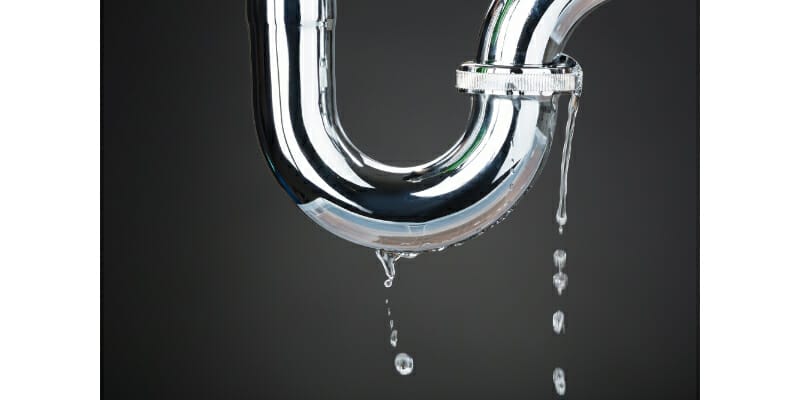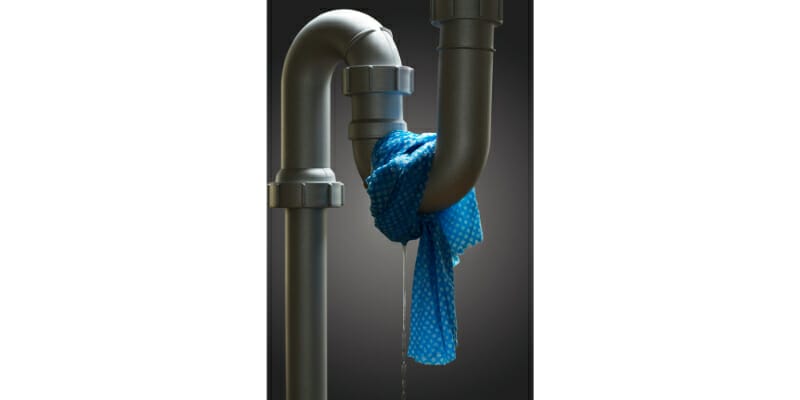Disclaimer: This post may contain affiliate links, meaning we get a small commission if you make a purchase through our links, at no cost to you. For more information, please visit our Disclaimer Page.
There’s nothing more frustrating than a leaking pipe. It not only wastes water, it also can cause damage to your floors and furniture.
A leaking pipe is a temporary fix and you can do it by yourself. You can buy materials on hardware such as rubber sheets, rubber sealing gasket, coupling adapter, and coupling with steel clamps. The temporary fix may only lasts for a few days so call a licensed plumber to do the permanent fix.

Table of Contents
Can I fix a leaky pipe without replacing it?
You can fix a leaky pipe without replacing it in the meantime, as it’s considered an emergency fix. However, if you want to solve it as fast as possible, calling a licensed plumber is a must. A licensed plumber has the right training and has the right tools to do the job.
If you’re thinking that you can save money by just fixing a leaky pipe without replacing it, that’s a myth that you must forget. I’ll give you reasons you must replace it right away.
Water leak can create expensive damage to other areas of your home, so you may be required to fix those parts as well. So, instead of just spending money on hiring a licensed plumber, you’ll need to spend extra cash for the other repairs. On top of it, you must expect a large water bill.
Health problems are another reason you need to replace a leaky pipe rather than fixing it temporarily. Molds grow in a wet and dark area, which is the same spot where a leak occurs. When mold spores get in the air, they can trigger allergies and respiratory infections. Also, when there’s a leaky pipe, your water may get contaminated.
If you’re planning to sell your house, a permanent code-compliant repair is required. It’s not a good idea to sell your house with temporarily fixed pipes. You must replace your leaky pipe. Let a licensed plumber do the permanent repair.
Although paying a licensed plumber is more expensive than buying a DIY kit, the permanent fix can serve you for years. You can even ask for recommendations from a licensed plumber to get the best options available.
Maintenance check-up is also offered that you can take advantage of so you won’t encounter a leakage in the future.
Is there a temporary fix for the leaking pipe?
Fixing a leaking pipe can be done temporarily and permanently. In most cases, it’s the homeowner who does the temporary fix while a licensed plumber then does the permanent fix.
If you plan to DIY, the first thing you need to do is to identify the location of the leak. It can be found mid-run or on the joints. These two locations require different materials to stop the leak. In addition, the type of pipe also matters to match the materials for a quick fix.
How do you temporarily fix a leaky pipe?
On the onset that you realized that there’s a leaky pipe. The first thing you need to do is to shut off the main water pipeline. Then check your water meter. If the water meter continues to run when everything else is shut down, 100% there’s a leak.
This step is important because sometimes there’s no leak at all. Maybe someone forgot to turn off the faucet. That’s why it looks like there’s a leak. Sometimes, water just entered the pull-out kitchen faucet, which may lead you to think that the pipe leaks under your sink
When you confirm that there’s a leaky pipe, start to locate the leak. Check the joints of the pipe or the mid-run. You need to identify the location of the leak before running to the store.
However, if the leaky pipe happens in your building’s office and you can’t shut off the main water pipeline, you can do the fix and then call a licensed plumber. In this kind of setup, calling a professional plumber is necessary. It’s a large-scale project and hiring an expert can ease your worries.
Joint leak vs Mid-run leak
A joint leak is a leak you find in the connector of the pipes. On the other hand, a mid-run leak means that there’s a pinhole somewhere in the pipe. Determining the location of the leak is important because you need different tools for each area.
For joint leaks, you can use a fiberglass patch to wrap the leaking area. Fiberglass wrap is water activated and it becomes cast-like when it hardens. You can also use epoxy or self-fusing silicone tape.
However, self-fusing silicone tape only works on minor leaks and low-pressure pipes. When a heating system is used, silicone tape is not recommended. For mid-run leaks, clamps, compression coupling, and rubber gasket work best.
After you identify the location of the leak, take a picture of the pipe. It will be your guide as you buy the repair tools.
Pipe types
There are five types of pipes and you must identify the pipe type that you have before you go to the hardware store.
One of the most common types is the galvanized pipe. It’s the silver pipe you often see outside your house. PVC and CPVC are also the common types as well as copper pipe and PEX pipe.
You must identify each type to match it with the right repair kit. It’s not a good idea that you use a metal compression coupling for PVC or CPVC pipes.
But before going to the hardware, you must measure the diameter of the pipe. The coupling or the ring must fit snugly to the pipe. You don’t want too tight or too loose to avoid force tightening the coupling, especially on a PVC or CPVC as it may break the pipe.
Fixing pipes
A joint leak is easy to fix. You just need to wrap a fiberglass patch, epoxy, and silicone tape to the leak area.
For the silicone tape, make sure that you stretch it all the way around to compress the water that comes out of the pipe.
If you can shut off the main water pipeline, it’s better so the patch and tape can do their work. However, if you can’t shut off, don’t start wrapping in the area where the water goes out.
Start wrapping near the pinhole then continue wrapping to the area where the pinhole is located.
Mid-run is a bit challenging because you need to use a rubber sheet and a clamp to do it. Sometimes you may need a coupling, which is a bit complicated.
I recommend using the rubber gasket and hose clamp combination because it is the most reliable among the options available. It is easy to use and perfect for heating systems and domestic water.
To fix the leaky pipe with a rubber gasket and a hose clamp, you must cut the rubber sheet with the same width as the hose clamp. You don’t need to cover the entire diameter of the pipe. You just need to cover the pinhole. Then use the clamp to tighten it enough to hold the gasket in place.
In case you’re interested in using a coupling, here are the steps to solve the leaky pipe problem. The first thing you need to do is to make sure that the coupling fits the pipe. Then cut out the damaged pipe using a saw. Connect the pipe using the coupling and tighten it.
When using a coupling, you must make sure that after cutting the pipe, you deburr it. Deburring can avoid turbulence when the water flows in the pipe. You can use a special tool or a sharp knife to deburr it.

Conclusion
A temporary patch for a leaking pipe is a skill you may wish to acquire since emergencies may occur at any time of day or night. You can keep a repair kit on your house that matches the pipes you have.
However, you must call a licensed plumber right away to schedule the permanent repair. You must not wait longer to avoid further damage to your property.
